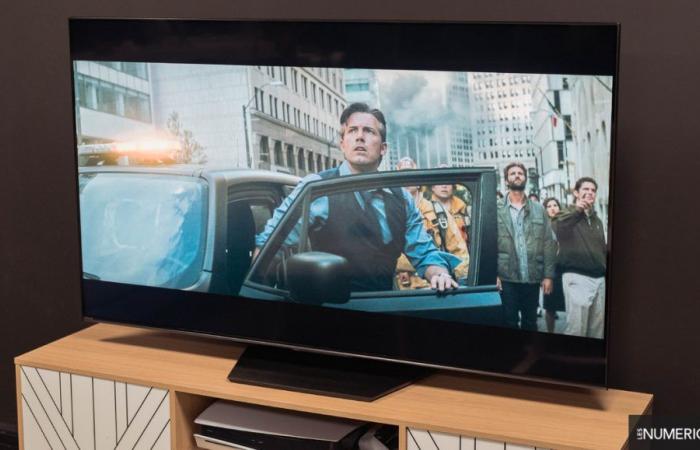Image quality
The 65U7NQ features a Mini-Led panel and as always it is VA LCD as seen in our subpixel photo below.
Subpixels are characteristic of a VA LCD panel.
The image quality is frankly good overall and the Mini-Led proves itself with very good contrasts and excellent color reproduction. In Filmmaker mode, the usually best calibrated mode, the average delta E is only 1.4, well below the limit of 3 from which we consider that the colors are no longer faithful. All the colors are perfectly precise and only the whites drift slightly.
Compare photos
3 – Average Delta E SDR measured at 1.4 2 – Gamma curve – average 2.3 1 – Color temperature curve – average 7131
On the other hand, the average temperature of 7130 K is a little more lacking and the TV tends towards blue. We actually expect a temperature of 6500 K at the cinema. The dynamic contrast climbs to 7900:1 and the native contrast to 3930:1. It is not at the level of the best Mini-led TVs, and obviously far from the Oled models, but the blacks are quite deep. By deactivating the local dimmingthe results become catastrophic and it is therefore absolutely necessary to leave it on Low. The gray levels are for their part well reproduced with an average gamma of 2.27, slightly overexposed, but nothing too bad.
As is often the case with VA panels, viewing angles are not very good. We measured a 57% loss of brightness at an angle of 45; people not sitting in front of the screen will see a degraded image as a result.
Apocalypse Now on the Hisense U7NQ.
HDR
Good news, the Hisense U7NQ is compatible with all HDR formats, whether classic HDR10 and HLG, or dynamic HDR Dolby Vision and HDR10+.
The peak brightness climbs to 1100 cd/m² on a 10% window, which is quite high for a mid-range model. That said, it does not reach the levels of the best Oled TVs which exceed 1600 cd/m² or the Sony Bravia 7, a Mini-led model which peaks at 1850 cd/m².
On the left, the EOTF curve in HDR10, 10% window; on the right, the HDR luminance curve, 10% window.
With a 10,000 cd/m² signal, the EOTF curve is followed very well, but the TV gently smooths the curve from 80% to avoid the clipping (loss of detail in highlights). On the other hand, by sending a signal at 1000 cd/m², the TV applies the same processing, while it should be able to follow the curve perfectly…
HDR Colorimetry – Filmmaker Mode. Average Delta E at 1.9.
The colorimetry in HDR is as precise as in SDR with an average delta E of 1.9. Due to the Mini-Led panel, the colorimetric coverage is not perfect and we note roughly the same values as usual: 90% of DCI-P3 is covered for only 70% of Rec.2020. In this area, Oled and especially QD-Oled do better.
On the left, the coverage of the DCI-P3 space; on the right, the REC-2020.
The Hi-View processor’s motion compensation (MEMC) is also effective, but we can only advise you to turn it off when watching a film. The Filmmaker mode will disable any improvement in fluidity by default anyway. We did however observe a little solarization in certain scenes, as in Blade Runner 2049 (upper right corner).
Clouding et blooming
We noticed a bit of banding on our test specimen with slightly dark spots on a light background. Thanks to the Mini-Led technology, there is no clouding (light spots on dark background) and the blooming (halo effect around bright objects) is limited, although present. We measured a white homogeneity of 6% across the entire panel, which is not the best result of our comparison, but undetectable to the naked eye.
Reflectance
Hisense advertised a reduction in reflections on this range, but the average reflectance of 28% is marked here and similar to that of the 65U8KQ of 2023. In this area, LG Display’s Vanta Black filter does much better with 18% reflectance, as does Samsung with the new anti-reflective coating of the S95D. Other Mini-Led and LCD TVs do much worse with a reflectance of 40%.
Video games
For a mid-range model, the U7NQ still climbs to 144 Hz and offers FreeSync Premium Pro to avoid image tearing. Obviously, the afterglow measured at 9 ms is not at the level of the Oled, but it remains limited and we should not see any ghosting playing.
The input lag isn’t the best either, but it won’t impact most players. At 17ms, there’s only a one-frame delay between the moment you click a button on a controller and the moment the action takes place on screen. A difference that’s hard to notice.
Hisense has been smart in its management of game mode in terms of colorimetry: there is no profile to this in the menus next to standard, Filmmaker, sport, etc. modes. Activating game mode will only unlock the dedicated features (ALLM, noise reductioninput lagetc.) and will leave the color profile as is. By staying in Filmmaker mode, the colors are therefore perfectly faithful, in SDR or HDR.
Finally, this TV only has two HDMI 2.1 ports compatible with 4K 120 Hz, ALLM (Auto Low Latency Mode) and VRR (Variable Refresh Rate) on the back. You will have to turn to another model to take advantage of four HDMI 2.1 ports.
Ergonomics
The Hisense U7NQ is installed quite easily by attaching the two feet with four screws. A clip-on cover then covers everything. This imitates a brushed metal effect, but it is made of plastic and does not necessarily exude quality, just like the design of the entire TV, also entirely made of plastic. Concessions had to be made to reduce the bill…
The TV stand is fitted with a somewhat “cheap” plastic cover.
The TV measures 167 x 103 cm with the stand and its depth is 34 cm. The central stand will not allow you to install a sound bar at the front, unless you have a fairly wide TV cabinet, which is not the case with ours.
The back of the TV and its woofers.
On the back of the TV, we identify a cable management system and a complete connectivity. There are two HDMI 2.1 ports, including one eArc and two HDMI 2.0 ports, two USB-A ports (including one 3.0), an Ethernet port, a tuner with satellite and cable sockets, a CI+ (Common Interface) port and an optical digital audio output. For connectivity, Bluetooth 5.1 and wifi 6 are of course included.
The connections at the back.
Hisense’s Vidaa interface is not disorienting compared to competing OSs. Despite a few small hiccups from time to time, the OS is fluid and has all the usual streaming apps, from Netflix to Molotov, Disney+, Arte and Amazon Prime Video. The TV is compatible with AirPlay, but unfortunately not Chromecast. Alexa is present, but the TV can also be controlled by Vidaa Voice thanks to the microphone integrated into the remote control.
L’interface Vidaa U 7.6.
This one offers a lot of features! By integrating a numeric keypad, shortcuts to streaming apps, a selection wheel and a solar panel at the very bottom, Hisense may have wanted to do too much. It nevertheless has the advantage of being complete and the solar panel is a good idea, but the ergonomics and design need to be reviewed. It can also be recharged thanks to the USB-C port.
The remote control is very (too) long.






